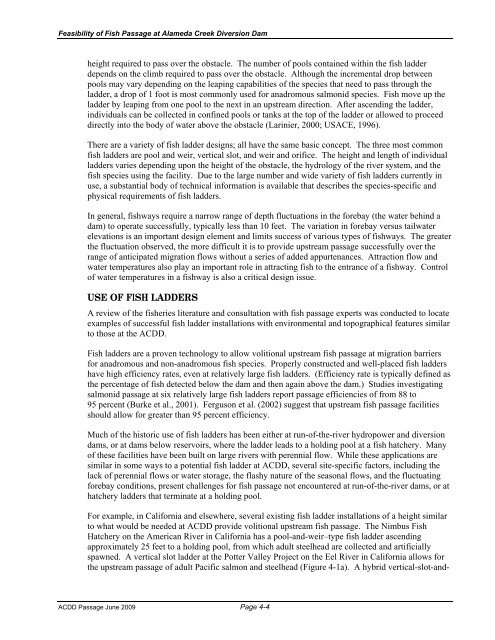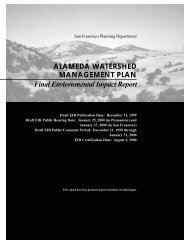Feasibility of Fish Passage at Alameda Creek Diversion Dam
Feasibility of Fish Passage at Alameda Creek Diversion Dam
Feasibility of Fish Passage at Alameda Creek Diversion Dam
Create successful ePaper yourself
Turn your PDF publications into a flip-book with our unique Google optimized e-Paper software.
<strong>Feasibility</strong> <strong>of</strong> <strong>Fish</strong> <strong>Passage</strong> <strong>at</strong> <strong>Alameda</strong> <strong>Creek</strong> <strong>Diversion</strong> <strong>Dam</strong>height required to pass over the obstacle. The number <strong>of</strong> pools contained within the fish ladderdepends on the climb required to pass over the obstacle. Although the incremental drop betweenpools may vary depending on the leaping capabilities <strong>of</strong> the species th<strong>at</strong> need to pass through theladder, a drop <strong>of</strong> 1 foot is most commonly used for anadromous salmonid species. <strong>Fish</strong> move up theladder by leaping from one pool to the next in an upstream direction. After ascending the ladder,individuals can be collected in confined pools or tanks <strong>at</strong> the top <strong>of</strong> the ladder or allowed to proceeddirectly into the body <strong>of</strong> w<strong>at</strong>er above the obstacle (Larinier, 2000; USACE, 1996).There are a variety <strong>of</strong> fish ladder designs; all have the same basic concept. The three most commonfish ladders are pool and weir, vertical slot, and weir and orifice. The height and length <strong>of</strong> individualladders varies depending upon the height <strong>of</strong> the obstacle, the hydrology <strong>of</strong> the river system, and thefish species using the facility. Due to the large number and wide variety <strong>of</strong> fish ladders currently inuse, a substantial body <strong>of</strong> technical inform<strong>at</strong>ion is available th<strong>at</strong> describes the species-specific andphysical requirements <strong>of</strong> fish ladders.In general, fishways require a narrow range <strong>of</strong> depth fluctu<strong>at</strong>ions in the forebay (the w<strong>at</strong>er behind adam) to oper<strong>at</strong>e successfully, typically less than 10 feet. The vari<strong>at</strong>ion in forebay versus tailw<strong>at</strong>erelev<strong>at</strong>ions is an important design element and limits success <strong>of</strong> various types <strong>of</strong> fishways. The gre<strong>at</strong>erthe fluctu<strong>at</strong>ion observed, the more difficult it is to provide upstream passage successfully over therange <strong>of</strong> anticip<strong>at</strong>ed migr<strong>at</strong>ion flows without a series <strong>of</strong> added appurtenances. Attraction flow andw<strong>at</strong>er temper<strong>at</strong>ures also play an important role in <strong>at</strong>tracting fish to the entrance <strong>of</strong> a fishway. Control<strong>of</strong> w<strong>at</strong>er temper<strong>at</strong>ures in a fishway is also a critical design issue.USE OF FISH LADDERSA review <strong>of</strong> the fisheries liter<strong>at</strong>ure and consult<strong>at</strong>ion with fish passage experts was conducted to loc<strong>at</strong>eexamples <strong>of</strong> successful fish ladder install<strong>at</strong>ions with environmental and topographical fe<strong>at</strong>ures similarto those <strong>at</strong> the ACDD.<strong>Fish</strong> ladders are a proven technology to allow volitional upstream fish passage <strong>at</strong> migr<strong>at</strong>ion barriersfor anadromous and non-anadromous fish species. Properly constructed and well-placed fish laddershave high efficiency r<strong>at</strong>es, even <strong>at</strong> rel<strong>at</strong>ively large fish ladders. (Efficiency r<strong>at</strong>e is typically defined asthe percentage <strong>of</strong> fish detected below the dam and then again above the dam.) Studies investig<strong>at</strong>ingsalmonid passage <strong>at</strong> six rel<strong>at</strong>ively large fish ladders report passage efficiencies <strong>of</strong> from 88 to95 percent (Burke et al., 2001). Ferguson et al. (2002) suggest th<strong>at</strong> upstream fish passage facilitiesshould allow for gre<strong>at</strong>er than 95 percent efficiency.Much <strong>of</strong> the historic use <strong>of</strong> fish ladders has been either <strong>at</strong> run-<strong>of</strong>-the-river hydropower and diversiondams, or <strong>at</strong> dams below reservoirs, where the ladder leads to a holding pool <strong>at</strong> a fish h<strong>at</strong>chery. Many<strong>of</strong> these facilities have been built on large rivers with perennial flow. While these applic<strong>at</strong>ions aresimilar in some ways to a potential fish ladder <strong>at</strong> ACDD, several site-specific factors, including thelack <strong>of</strong> perennial flows or w<strong>at</strong>er storage, the flashy n<strong>at</strong>ure <strong>of</strong> the seasonal flows, and the fluctu<strong>at</strong>ingforebay conditions, present challenges for fish passage not encountered <strong>at</strong> run-<strong>of</strong>-the-river dams, or <strong>at</strong>h<strong>at</strong>chery ladders th<strong>at</strong> termin<strong>at</strong>e <strong>at</strong> a holding pool.For example, in California and elsewhere, several existing fish ladder install<strong>at</strong>ions <strong>of</strong> a height similarto wh<strong>at</strong> would be needed <strong>at</strong> ACDD provide volitional upstream fish passage. The Nimbus <strong>Fish</strong>H<strong>at</strong>chery on the American River in California has a pool-and-weir–type fish ladder ascendingapproxim<strong>at</strong>ely 25 feet to a holding pool, from which adult steelhead are collected and artificiallyspawned. A vertical slot ladder <strong>at</strong> the Potter Valley Project on the Eel River in California allows forthe upstream passage <strong>of</strong> adult Pacific salmon and steelhead (Figure 4-1a). A hybrid vertical-slot-and-ACDD <strong>Passage</strong> June 2009 Page 4-4








